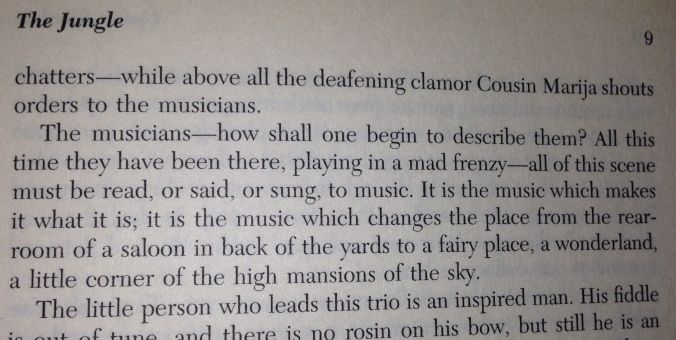
A coworker recently lent me a copy of The Jungle, a book I’ve managed to avoid for 30 years either by chance or, more likely, by ignoring a series of well-intentioned high school and/or college reading assignments.
But I’m getting better! I read Hard Times on the way to Greece earlier this year, and I started making my way through The Jungle early last week. Almost right away, I encountered a paragraph that was totally unrelated to meat packing or the plight of the downtrodden factory worker but was instead a totally insightful take on the magic of live music.
Here it is:
The musicians — how shall one begin to describe them? All this time they have been there, playing in a mad frenzy — all of this scene must be read, or said, or sung, to music. It is the music which makes it what it is; it is the music which changes the place from the rear-room of a saloon in back of the yards to a fairy place, a wonderland, a little corner of the high mansions of the sky.
The “scene” Sinclair is describing is a Lithuanian wedding reception, but you could apply this passage to any setting in which people have picked up instruments and started making other people dance or sing or reflect. Reading it makes me smile, and it distills wonderfully a thought that occurs to me every now and then when I’m looking around the room during a concert.
As you’re walking in, music venues can seem like sci-fi portals. You pass through this door — a door you might have walked through a dozen times before — but what greets you on the other side is an utterly unique display put on by larger-than-life performers who are often from far away lands, and all you have to do is pay for a ticket, stand there and soak it all in. Maybe you feel this way about going to the movies, or about a restaurant that’s home to a particularly inventive chef. For me it’s music venues, and in my most euphoric concert-going moments, the whole thing really does seem like something out of science fiction.
But when you look around at your favorite venue — up, at the pattern on the ceiling or at the dusty corners of the room, or down, at the shiny stickiness of dried, spilled beer — a different picture comes into focus. The 9:30 Club in Washington, D.C. The Doug Fir Lounge in Portland, OR. The National in Richmond, VA. These places have names, and those names can signify distinctive scenes or storied histories, but the buildings themselves are collections of components that could make up any building. Walls. Electrical wiring. HVAC systems. They’re rooms that have flooring imperfections and sit quiet for huge stretches of time, just like any room in your home. They’re ordinary in so many ways. (OK, maybe not the Doug Fir, which is extraordinarily creepy in the best ski-lodge-murder-scene kind of way and probably gets even creepier in between shows.)
This may seem unromantic, but to me, it’s just the opposite. It brings into focus how spectacular the portal transformation really is, and how much hard work and star-alignment is required for it to take place. There’s a moment from Townes Van Zandt’s Live at the Old Quarter, Houston, Texas album that I’ve always loved, and it bridges the two sides of this phenomenon perfectly. Just before starting “Pancho And Lefty,” Van Zandt addresses the audience by saying “Sorry about the air conditioners being off, but it won’t be very long. [If] it gets really hot, I don’t know what we’ll do.” It’s a small, lower-case-m moment in a seriously momentous performance, but it does a great job of drawing you into the physical reality of what being at The Old Quarter in July of 1973 would have been like. Check it out below.
Townes Van Zandt — “Pancho And Lefty” (live) [Spotify/iTunes]